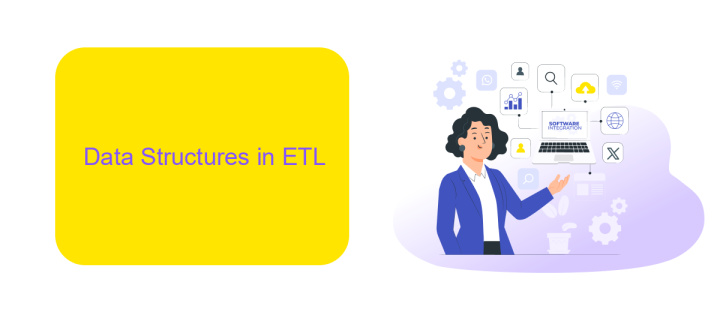ETL Data Structures
ETL (Extract, Transform, Load) data structures are fundamental components in data processing and analytics. They enable the seamless transfer of data from various sources, its transformation into a usable format, and its efficient loading into target systems. Understanding these structures is crucial for optimizing data workflows and ensuring the accuracy and reliability of business intelligence and analytics initiatives.
Introduction
ETL (Extract, Transform, Load) processes are fundamental in managing and organizing data within modern enterprises. These processes involve extracting data from various sources, transforming it into a suitable format, and loading it into a destination system. Efficient ETL data structures are crucial for ensuring data quality, consistency, and accessibility.
- Extract: Gathering data from multiple sources such as databases, APIs, and flat files.
- Transform: Converting data into a usable format, including data cleaning, normalization, and integration.
- Load: Inserting the transformed data into a target database or data warehouse.
Effective ETL data structures enable seamless data integration, which is vital for informed decision-making and analytics. Tools like ApiX-Drive can automate and streamline these processes, reducing manual effort and minimizing errors. By leveraging such services, organizations can focus on deriving insights from their data rather than getting bogged down in data management complexities.
Data Structures in ETL

In the realm of ETL (Extract, Transform, Load), data structures play a crucial role in ensuring the efficient processing and management of data. Common data structures such as arrays, linked lists, hash tables, and trees are utilized to organize and store data during the ETL process. Arrays and linked lists are often used for sequential data storage, while hash tables provide quick access to data through key-value pairs. Trees, particularly binary trees, are beneficial for hierarchical data representation and quick sorting operations.
When it comes to setting up integrations and automating data workflows, services like ApiX-Drive can be incredibly useful. ApiX-Drive simplifies the integration process by providing a user-friendly interface to connect various applications and automate data transfers. This reduces the complexity of handling data structures manually and ensures that data is accurately extracted, transformed, and loaded between systems. By leveraging such services, organizations can focus more on data analysis and decision-making rather than the intricacies of data management.
Data Structures for Storage

Effective data storage is crucial for any ETL process, ensuring that data is organized, accessible, and secure. Different data structures can be utilized depending on the specific requirements of the storage system. Choosing the right structure can significantly impact the efficiency and performance of data retrieval and manipulation.
- Arrays: Ideal for storing homogeneous data types in a contiguous block of memory, allowing for fast access and iteration.
- Linked Lists: Useful for scenarios requiring dynamic memory allocation, enabling efficient insertions and deletions.
- Hash Tables: Provide quick access to data through key-value pairs, excellent for lookups and indexing.
- Binary Trees: Allow hierarchical data storage, facilitating efficient searching, insertion, and deletion operations.
- Graphs: Suitable for representing complex relationships and networks, often used in social networks and recommendation systems.
When integrating various data sources, tools like ApiX-Drive can simplify the process. ApiX-Drive offers seamless integration capabilities, automating the data flow between different systems and ensuring that the chosen data structures are populated accurately and efficiently. This not only saves time but also reduces the risk of errors in the ETL pipeline.
Data Structures for Processing

When processing data in ETL pipelines, selecting appropriate data structures is crucial for efficiency and performance. Data structures help organize and manage data, ensuring smooth data transformation and loading processes.
Commonly used data structures in ETL processes include arrays, linked lists, hash tables, and trees. Each of these structures offers unique advantages depending on the specific requirements of the ETL task.
- Arrays: Ideal for sequential data processing and fixed-size datasets.
- Linked Lists: Suitable for dynamic data where insertions and deletions are frequent.
- Hash Tables: Excellent for quick data retrieval using key-value pairs.
- Trees: Useful for hierarchical data and efficient searching and sorting operations.
Integrating ETL processes with external services can further enhance data processing capabilities. For instance, ApiX-Drive can automate data transfer between various applications, streamlining the ETL workflow and reducing manual intervention. Choosing the right data structures and leveraging integration tools like ApiX-Drive can significantly optimize ETL operations.
- Automate the work of an online store or landing
- Empower through integration
- Don't spend money on programmers and integrators
- Save time by automating routine tasks
Conclusion
In summary, ETL data structures are fundamental for efficient data processing and transformation. They enable organizations to extract valuable insights from vast amounts of raw data by structuring and organizing it in a coherent manner. By leveraging these structures, businesses can streamline their workflows, enhance data quality, and make informed decisions based on accurate and timely information.
Moreover, integrating ETL processes with services like ApiX-Drive can further simplify and automate data management tasks. ApiX-Drive offers robust solutions for connecting various data sources and applications, ensuring seamless data flow and reducing the complexity of manual integrations. This not only saves time but also minimizes errors, allowing teams to focus on strategic initiatives rather than operational challenges. Embracing such tools and technologies is crucial for staying competitive in today's data-driven landscape.
FAQ
What is ETL in data structures?
Why is ETL important in data processing?
What are the common challenges faced in ETL processes?
How can ETL processes be automated?
What are the key components of an ETL process?
Apix-Drive is a universal tool that will quickly streamline any workflow, freeing you from routine and possible financial losses. Try ApiX-Drive in action and see how useful it is for you personally. In the meantime, when you are setting up connections between systems, think about where you are investing your free time, because now you will have much more of it.


